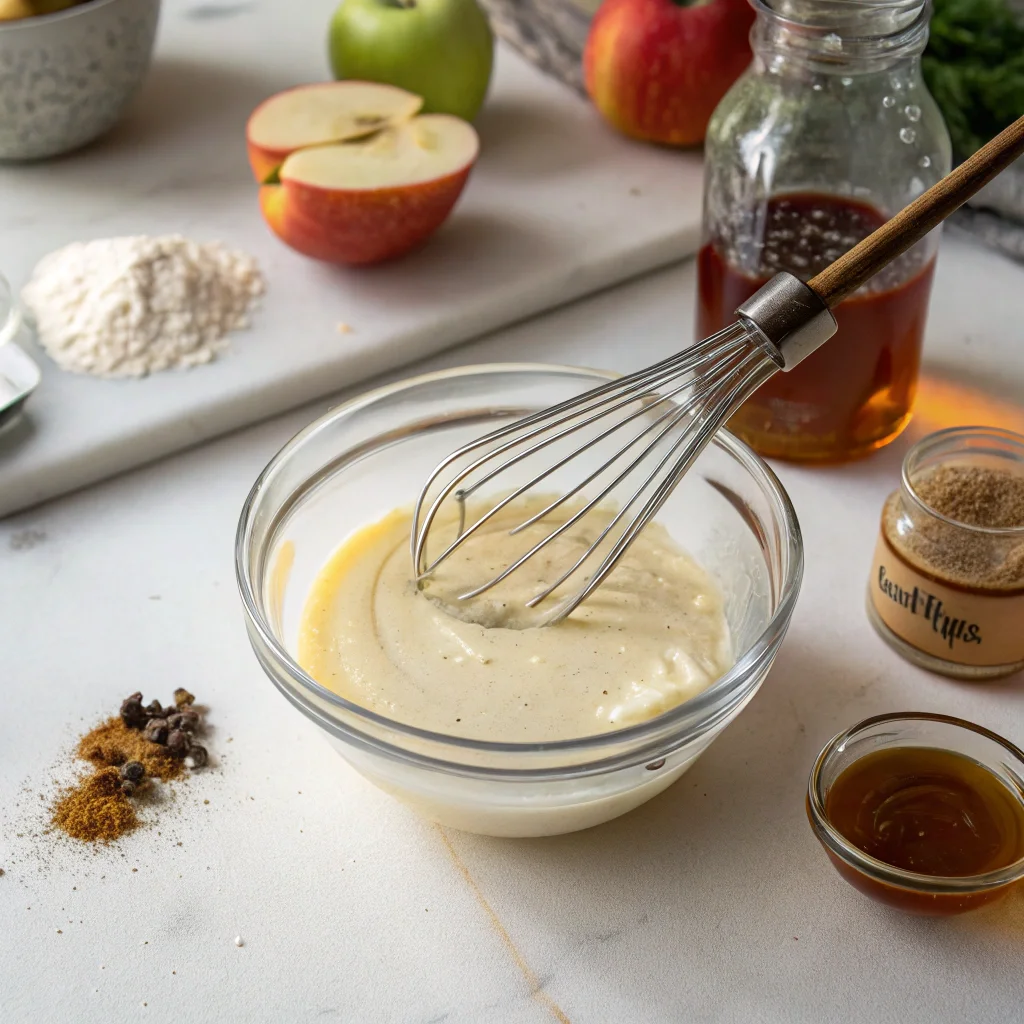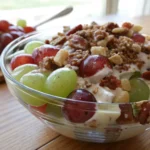When it comes to healthy, flavorful dishes that fit into any meal plan, the broccoli cauliflower salad recipe is a standout. This vibrant dish combines crisp vegetables, creamy dressing, and delicious add-ons to create a salad that is as nourishing as it is satisfying. In this article, you’ll learn everything you need to know to create this healthy masterpiece. Whether you’re hosting a party or preparing a quick family meal, this recipe will surely impress.
Table of Contents
Why Choose a Broccoli Cauliflower Salad Recipe?
The broccoli cauliflower salad recipe is more than just a tasty dish. It’s a nutritional powerhouse that brings together two of the healthiest vegetables in one bowl. Packed with fiber, vitamins, and antioxidants, this salad supports digestion, boosts immunity, and promotes heart health. Moreover, its versatility means you can adapt it to suit various tastes and dietary needs.
Key Benefits of This Recipe
- Nutritional Richness: Broccoli and cauliflower are rich in vitamins C and K, folate, and antioxidants.
- Ease of Preparation: With minimal cooking, this dish is perfect for busy schedules.
- Customizable: Add proteins like grilled chicken or switch up the dressing for a unique twist.
Ingredients for Broccoli Cauliflower Salad Recipe
A well-planned list of ingredients ensures your salad is both delicious and nutrient-rich.
| Ingredient Type | Quantity | Notes |
|---|---|---|
| Vegetables | ||
| Broccoli florets | 2 cups | Chop into bite-sized pieces. |
| Cauliflower florets | 2 cups | Chop into bite-sized pieces. |
| Red onion | ½ cup, diced | Adds a sharp, zesty flavor. |
| Optional Add-ons | Optional but highly recommended. | |
| Shredded cheddar cheese | ½ cup | For a creamy, rich taste. |
| Sunflower seeds | ¼ cup | Adds crunch and healthy fats. |
| Dried cranberries | ¼ cup | Balances flavors with natural sweetness. |
| Dressing | The key to bringing all flavors together. | |
| Mayonnaise or Greek yogurt | ½ cup | Adjust based on desired creaminess. |
| Apple cider vinegar | 2 tbsp | Provides tanginess. |
| Honey or sugar | 1 tbsp | Balances acidity. |
| Salt and pepper | To taste | Adjust to preference. |
Step-by-Step Guide to the Perfect Broccoli Cauliflower Salad Recipe
Follow these simple steps to prepare your broccoli cauliflower salad recipe.
1. Prepare the Vegetables
Begin by thoroughly washing the broccoli and cauliflower. Chop them into small, bite-sized florets to ensure even mixing. Dice the red onion for a burst of flavor.
2. Blanch the Vegetables (Optional)
Blanching is optional, but it softens the raw vegetables slightly while maintaining their crunch. To blanch:
- Bring a pot of water to a boil.
- Add the broccoli and cauliflower florets.
- Boil for 2–3 minutes, then immediately transfer to a bowl of ice water.
3. Prepare the Dressing

In a small bowl, whisk together:
- ½ cup mayonnaise or Greek yogurt.
- 2 tablespoons apple cider vinegar.
- 1 tablespoon honey or sugar.
- A pinch of salt and pepper.
Mix until smooth and creamy.
4. Combine the Ingredients
In a large bowl, combine:
- Prepared broccoli and cauliflower florets.
- Diced red onion.
- Optional add-ons like cheddar cheese, sunflower seeds, and dried cranberries.
5. Add the Dressing
Pour the dressing over the vegetables and mix well. Ensure all ingredients are evenly coated.
6. Refrigerate
For the best flavor, let the salad chill in the refrigerator for at least one hour. This allows the flavors to meld.
7. Serve and Enjoy
Before serving, sprinkle sunflower seeds on top for an extra crunch. Pair the salad with grilled meats or enjoy it on its own.
Nutritional Information: Broccoli Cauliflower Salad Recipe
This broccoli cauliflower salad recipe offers a rich combination of nutrients, making it both a flavorful and health-conscious choice. Below is a detailed breakdown of the nutritional content per serving (approximately 1 cup), based on the standard recipe without additional protein options.
| Nutrient | Amount per Serving | % Daily Value | Health Benefits |
|---|---|---|---|
| Calories | 180 kcal | 9% | Provides energy while maintaining a moderate calorie count for weight management. |
| Protein | 6 g | 12% | Essential for muscle repair, immune function, and overall cellular health. |
| Carbohydrates | 12 g | 4% | A source of energy, with a mix of simple and complex carbs for sustained fuel. |
| Dietary Fiber | 3 g | 12% | Supports digestion, regulates blood sugar levels, and promotes a feeling of fullness. |
| Total Fats | 12 g | 18% | Healthy fats contribute to brain health and help absorb fat-soluble vitamins. |
| Saturated Fats | 3 g | 15% | Moderate amounts provide energy but should be balanced with unsaturated fats. |
| Sugars | 5 g | — | Naturally occurring and added sugars contribute sweetness while keeping levels moderate. |
| Vitamin C | 80 mg | 90% | Boosts immune function, aids collagen production, and protects against free radicals. |
| Vitamin K | 60 mcg | 50% | Essential for blood clotting and bone health. |
| Folate | 75 mcg | 19% | Important for cell division and DNA synthesis, especially during growth or pregnancy. |
| Calcium | 60 mg | 6% | Supports strong bones and teeth while aiding in muscle function. |
| Iron | 1 mg | 6% | Crucial for oxygen transport in the blood and preventing anemia. |
| Potassium | 400 mg | 8% | Regulates fluid balance, nerve signals, and muscle contractions. |
| Sodium | 180 mg | 8% | Provides flavor but should be monitored for those on a low-sodium diet. |
| Magnesium | 25 mg | 6% | Vital for muscle relaxation, energy production, and overall cellular health. |
Ingredient-Specific Nutritional Insights
- Broccoli and Cauliflower:
- High in antioxidants like sulforaphane, which may reduce inflammation and protect against chronic diseases.
- A rich source of fiber, promoting gut health and aiding in weight management.
- Dried Cranberries (Optional):
- Add natural sweetness with a small amount of added sugar.
- Contain polyphenols that support heart health.
- Sunflower Seeds (Optional):
- Packed with healthy fats like omega-6 fatty acids and vitamin E, which protect cells from damage.
- Cheddar Cheese (Optional):
- Provides a source of calcium and protein.
- Enhances the creamy texture and savory taste.
- Dressing (Mayonnaise or Greek Yogurt):
- Mayonnaise adds creaminess and richness, while Greek yogurt provides probiotics for gut health and reduces calorie content.
Adjusting Nutritional Content
You can modify the broccoli cauliflower salad recipe to align with specific dietary needs:
- For Lower Calories: Replace mayonnaise with Greek yogurt or use a vinaigrette dressing.
- For Higher Protein: Add grilled chicken, chickpeas, or hard-boiled eggs.
- For a Low-Carb Version: Omit the dried cranberries and use a sugar-free sweetener in the dressing.
- For a Low-Fat Option: Reduce or eliminate cheese and opt for a light dressing.
Comparison to Other Salads
| Salad Type | Calories | Protein | Fiber | Vitamin C |
|---|---|---|---|---|
| Broccoli Cauliflower Salad | 180 | 6 g | 3 g | 80 mg |
| Classic Caesar Salad | 310 | 8 g | 2 g | 12 mg |
| Kale and Quinoa Salad | 250 | 7 g | 4 g | 50 mg |
| Greek Salad | 200 | 5 g | 2 g | 20 mg |
Key Nutritional Takeaways
- This broccoli cauliflower salad recipe is an excellent choice for those seeking a nutrient-dense, low-calorie meal.
- The high vitamin C content supports immunity, especially during cold seasons.
- The inclusion of fiber and healthy fats makes it satisfying and beneficial for digestive health.
Tips for the Best Broccoli Cauliflower Salad Recipe
Making a perfect broccoli cauliflower salad recipe doesn’t require culinary expertise, but following these tips can elevate the dish to a whole new level. Whether you’re a beginner or an experienced cook, these pointers will ensure your salad is fresh, flavorful, and perfectly balanced.
1. Choose the Freshest Ingredients
- Broccoli and Cauliflower: Opt for firm, bright green broccoli and creamy white cauliflower with no yellowing or brown spots.
- Red Onion: Look for a firm, shiny onion with no soft spots for the best crunch and flavor.
- Add-ons: Freshly shredded cheese and unroasted, unsalted sunflower seeds bring optimal taste and health benefits.
2. Prep Your Vegetables Properly
- Wash the broccoli and cauliflower thoroughly under running water to remove any dirt or debris.
- Cut the florets into uniform, bite-sized pieces for even mixing and a pleasant texture.
- If you prefer softer vegetables, blanch them for 2–3 minutes. Be sure to cool them quickly in ice water to preserve their crispness and color.
3. Balance the Dressing Flavors
The dressing is the heart of this recipe. To make it perfect:
- Combine tangy (apple cider vinegar), creamy (mayonnaise or Greek yogurt), and sweet (honey or sugar) elements.
- Adjust the sweetness to your preference, starting with less and adding more gradually.
- Add a pinch of salt and pepper to enhance all the flavors.
4. Customize for Dietary Needs
- For a lighter version: Replace mayonnaise with low-fat Greek yogurt or a vinaigrette.
- For added protein: Include grilled chicken, chickpeas, or boiled eggs.
- For a vegan option: Use plant-based mayonnaise and nutritional yeast instead of cheese.
“Explore creative ways to customize your salads, such as this Chicken Salad Chick recipe.”
5. Let the Salad Rest Before Serving
Allow the salad to chill in the refrigerator for at least one hour before serving. This resting period lets the flavors meld together, enhancing the taste.
6. Add Toppings Just Before Serving
- To retain their crunch, add sunflower seeds, nuts, or bacon bits just before serving.
- Dried cranberries or raisins can be added earlier, as they absorb some of the dressing and become plump.
7. Avoid Overmixing
- Gently toss the ingredients to avoid breaking the florets into smaller pieces, which could make the salad mushy.
- Use a large mixing bowl to ensure all components are evenly coated without crushing the vegetables.
8. Store Properly
- Refrigerate Leftovers: Store the salad in an airtight container for up to three days.
- Avoid Freezing: The vegetables may lose their crisp texture, and the dressing can separate when thawed.
9. Experiment with Add-ons
For variety, try these additional toppings:
- Seeds and Nuts: Pumpkin seeds, chopped almonds, or pecans for added crunch and nutrients.
- Fruits: Fresh apple slices or pomegranate seeds for a burst of sweetness.
- Cheese Variations: Feta, Parmesan, or even blue cheese for a different flavor profile.
10. Pair with the Right Dishes
This salad pairs well with many main courses:
- Grilled proteins like chicken, salmon, or steak.
- Sandwiches, wraps, or barbecue dishes for picnics or potlucks.
- Soups, such as tomato or butternut squash, for a balanced, hearty meal.
“Looking for more pasta-inspired salads? Check out this Caesar Pasta Salad Recipe.”
Variations to Try
If you’d like to experiment, here are some variations of the broccoli cauliflower salad recipe:
Vegan Version
- Use vegan mayonnaise or a tahini-based dressing.
- Replace cheese with nutritional yeast for a cheesy flavor.
Low-Carb Option
- Skip dried cranberries to reduce sugar content.
- Use a keto-friendly sweetener in the dressing.
Mediterranean Twist
- Add cherry tomatoes, kalamata olives, and feta cheese.
- Swap the dressing for a lemon-olive oil vinaigrette.
“For a refreshing twist, try a cucumber-based dish like the Logan Cucumber Salad Recipe.”
FAQs About Broccoli Cauliflower Salad Recipe: Common Questions Answered
What is the mix between broccoli and cauliflower?
The mix between broccoli and cauliflower refers to their combination in recipes like the broccoli cauliflower salad recipe. Both vegetables belong to the cruciferous family and share a mild, slightly nutty flavor. When combined, they provide a balance of texture—broccoli offers a firmer, crunchy bite, while cauliflower is softer and creamier. Together, they create a nutrient-packed blend rich in fiber, vitamins C and K, and antioxidants.
What is the healthiest way to eat broccoli and cauliflower?
The healthiest way to eat broccoli and cauliflower is to prepare them with minimal cooking or eat them raw. Raw broccoli and cauliflower retain their full nutritional content, including heat-sensitive nutrients like vitamin C and sulforaphane, a compound linked to anti-inflammatory and cancer-preventive benefits. Light steaming or blanching is another excellent option, as it softens the vegetables while preserving most of their nutrients.
Can you eat broccoli raw in a salad?
Yes, you can eat broccoli raw in a salad. Raw broccoli adds a satisfying crunch and retains its full range of nutrients, including fiber, vitamins, and antioxidants. To enhance its flavor, consider pairing it with a creamy or tangy dressing, as in the broccoli cauliflower salad recipe. If the raw texture is too firm for your liking, blanching is a great alternative to soften the florets slightly.
Why do you blanch broccoli for salad?
Blanching broccoli for a salad is a technique used to soften its texture while preserving its bright green color and nutrients. This process removes any bitterness and enhances the broccoli’s natural flavor. Additionally, blanching makes the broccoli easier to chew and more appealing, especially for individuals who find raw broccoli too tough or bitter.
How long do you blanch cauliflower and broccoli?
To blanch broccoli and cauliflower for a salad:
- Bring a pot of water to a rolling boil.
- Add the broccoli florets and blanch for 2–3 minutes.
- For cauliflower, blanch for 3–4 minutes since it is slightly denser.
- Immediately transfer the vegetables to a bowl of ice water to halt the cooking process and maintain their texture and color.
What happens if you don’t blanch broccoli?
If you don’t blanch broccoli, it remains entirely raw, retaining its firm texture and slightly bitter taste. While raw broccoli is nutrient-rich and perfectly safe to eat, it might not be as palatable for everyone. Without blanching, the broccoli may also lack the vibrant green color that makes salads visually appealing. For salads like the broccoli cauliflower salad recipe, blanching enhances both flavor and presentation.
Conclusion about Broccoli Cauliflower Salad Recipe
The broccoli cauliflower salad recipe is a must-try for anyone seeking a healthy, versatile, and delicious dish. Its nutrient-packed ingredients, creamy dressing, and crunchy toppings make it a standout choice for any occasion. Whether you’re a seasoned cook or a beginner, this recipe’s simple steps always ensure success.
So, gather your ingredients and create a salad that’s as wholesome as it is satisfying. Your taste buds and your body will thank you!






